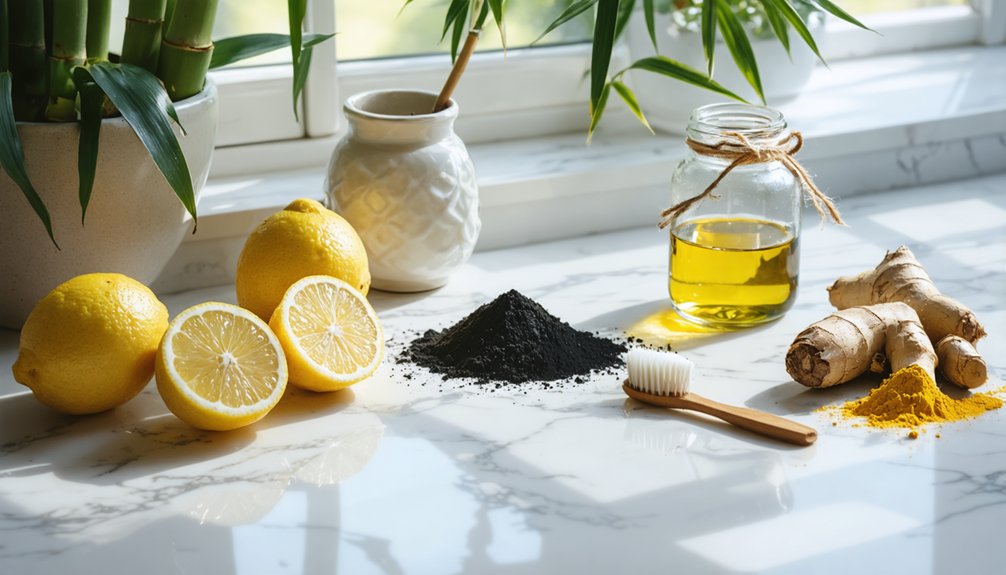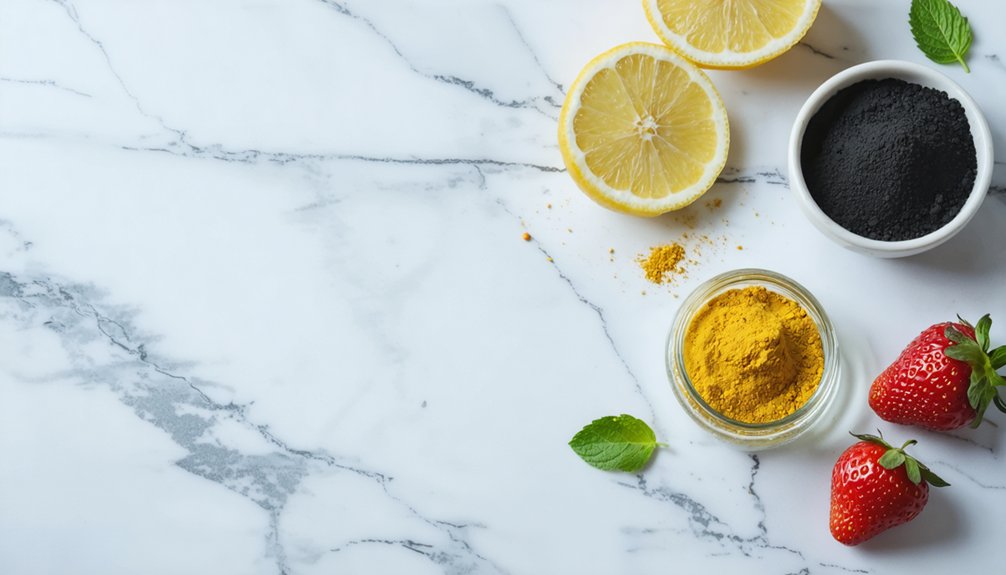For discolored teeth, you’ll find several effective organic whitening options. Activated charcoal-based products offer natural stain absorption, while baking soda-enhanced toothpaste provides gentle yet consistent results. Professional peroxide-free treatments under supervision deliver controlled whitening. Enzyme-based fruit treatments and oil pulling with plant oils can target surface stains effectively. When combined strategically, these natural methods amplify results while protecting your enamel. Understanding the right application techniques will maximize your whitening success.
Key Takeaways
- Activated charcoal powder effectively absorbs surface stains naturally while being gentle on tooth enamel when used properly.
- Baking soda-based natural toothpaste provides consistent whitening through mechanical abrasion and alkaline stain removal properties.
- Strawberry-based treatments contain malic acid that naturally removes surface stains when applied for short durations.
- Coconut oil pulling helps reduce plaque buildup and gradually lightens teeth through natural antibacterial properties.
- Professional-grade hydroxyapatite whitening products offer peroxide-free, enamel-safe organic whitening for deeper stains.
Understanding Organic Teeth Whitening: Benefits and Limitations
The allure of organic teeth whitening has gained considerable momentum as people seek natural alternatives to professional treatments.
However, you’ll need to understand both the benefits and limitations to avoid organic whitening misconceptions. While these methods offer affordability and accessibility, their effectiveness often falls short of professional solutions. Popular natural ingredients like coconut oil pulling lacks scientific backing for whitening claims. Consulting with a licensed dentist beforehand helps determine if natural whitening methods are appropriate for your specific dental needs.
Natural methods effectiveness varies considerably, primarily addressing only surface stains rather than deep discoloration.
While natural teeth whitening can tackle surface stains, it rarely penetrates deeper to address more stubborn discoloration issues.
Though they’re gentler on your wallet and avoid harsh chemicals, organic whitening agents can still pose risks. You’ll need to exercise caution, as improper use of even natural substances like baking soda or activated charcoal can damage your enamel irreversibly.
When choosing organic whitening options, consider that results typically require consistent, long-term application and may not match the dramatic improvements of professional treatments.
Natural Ingredients That Actually Work for Whiter Teeth
Scientific evidence reveals several natural ingredients can effectively contribute to teeth whitening, though their efficacy varies considerably. Some DIY whitening methods can cause permanent enamel damage.
When seeking natural solutions, you’ll find that strawberry benefits include mild but noticeable stain removal through natural acids, while baking soda effects demonstrate significant whitening power through mechanical abrasion of surface stains. Professional dental advice strongly recommends avoiding DIY methods using undiluted acids or abrasives.
- Strawberries mixed with baking soda create a gentle yet effective whitening paste that’s supported by clinical studies.
- Activated charcoal proves particularly effective at absorbing surface stains without harsh chemicals.
- Properly diluted lemon applications show whitening comparable to some commercial products.
- Baking soda provides reliable whitening through its mild abrasive properties.
- Natural fruit acids from strawberries offer a safe alternative for those with sensitive teeth.
Remember to use these methods cautiously, as overuse can damage enamel. Always consult your dentist before starting any whitening regimen.
SNOW’s Advanced Vitamin-Infused Formula: A Closer Look
Moving beyond basic natural ingredients, SNOW’s Advanced Vitamin-Infused Formula represents a sophisticated approach to teeth whitening through its innovative combination of active compounds.
SNOW’s vitamin-enriched formula elevates natural teeth whitening through advanced compounds, offering a sophisticated alternative to conventional treatments.
You’ll find nano hydroxyapatite benefits that include enamel remineralization and micro-crack repair, enhancing tooth brightness naturally. The formula’s CoQ10 properties deliver antioxidant protection while reducing periodontal inflammation. The non-abrasive formula protects tooth enamel while effectively lifting stains.
This advanced formulation combines Vitamins B6 and B12 to support gum health, while controlled hydrogen peroxide concentrations gently lift stains. The inclusion of magnesium and coconut oil provides antimicrobial protection and mineral support.
Clinical studies demonstrate a 1.5-shade improvement over eight weeks of consistent use. For your patients seeking natural whitening solutions, this fluoride-free option offers thorough care through its vitamin-enriched, sensitivity-conscious approach. A convenient TSA friendly 3 oz tube ensures easy travel compliance while maintaining a full month’s supply.
Safe Alternatives to Peroxide-Based Whitening Products
While traditional teeth whitening often relies on peroxide-based formulas, several safe and effective alternatives have emerged for patients seeking gentler options.
These holistic approaches prioritize ethical sourcing and natural ingredients, offering solutions that protect your enamel while achieving noticeable results. A thorough dental examination is essential before starting any whitening treatment to ensure optimal safety and effectiveness. Higher peroxide levels in traditional whitening products can increase tooth sensitivity risks.
- Activated charcoal applications provide natural stain absorption without harsh chemicals
- Professional peroxide-free treatments, like ALPINE WHITE, offer controlled whitening under expert supervision
- Baking soda-enhanced toothpaste delivers gentle yet effective stain removal
- Oil pulling methods using natural plant oils support oral health while targeting surface stains
- Enzyme-based fruit treatments can assist with whitening, though they require careful application
You’ll find these alternatives particularly beneficial if you’ve experienced sensitivity to traditional whitening methods.
Professional supervision guarantees ideal results while maintaining your dental health, making these options increasingly popular among health-conscious individuals.
Best Practices for Using Organic Teeth Whitening Methods
Now that you’ve selected your organic whitening method, proper application techniques will determine your success and protect your dental health.
When using natural remedies, apply baking soda paste gently with a soft-bristled brush, and limit activated charcoal use to prevent enamel wear. Taking a holistic approach means integrating these treatments with your regular oral care routine while monitoring for sensitivity.
For best results, maintain consistent application over 2-4 weeks, but don’t exceed recommended frequencies. Natural remedies often produce less dramatic results compared to professional treatments. Rinse thoroughly after using acidic substances, and avoid mixing incompatible ingredients like lemon juice with bicarbonate.
Remember to continue your regular brushing and flossing while using organic whitening methods, and use non-abrasive toothpaste to prevent cumulative damage.
If sensitivity develops or you don’t see improvement after several weeks, consult your dental professional.
Combining Different Natural Approaches for Better Results
You’ll find that certain natural teeth whitening methods work synergistically when combined thoughtfully, such as using strawberries with baking soda to leverage both malic acid and gentle abrasion.
When selecting combinations, prioritize ingredients known to be safe for tooth enamel, like oil pulling with coconut oil followed by activated charcoal application, rather than highly acidic options that risk damage.
For best results, you’ll want to maintain consistent application of your chosen combination while monitoring your teeth’s response to guarantee the method remains gentle yet effective.
Natural Methods Work Together
Although individual natural teeth whitening methods can be effective on their own, combining different approaches strategically can amplify your results through complementary mechanisms.
Natural method effectiveness increases when you pair ingredients that work together synergistically, targeting stains through multiple actions while maintaining oral health.
- Combine baking soda with strawberries to leverage both gentle abrasion and malic acid’s natural whitening properties.
- Enhance oil pulling’s bacterial reduction by adding activated charcoal for deeper stain removal.
- Rotate between different natural methods weekly to prevent overuse while maintaining consistent results.
- Create a balanced paste using baking soda and apple cider vinegar for enhanced stain-fighting power.
- Integrate multiple gentle approaches instead of relying on harsh single ingredients to protect your enamel while achieving desired results.
Safe Ingredient Combinations First
Combining natural teeth whitening ingredients requires careful consideration of their chemical interactions and safety profiles.
You’ll find baking soda benefits are most effective when paired with controlled amounts of hydrogen peroxide, creating a gentle yet powerful whitening paste. Mix one part baking soda with two parts hydrogen peroxide for ideal results.
When incorporating activated charcoal, combine it with mint extracts and sodium bicarbonate to enhance both cleaning power and oral health protection.
For fruit-based treatments, limit exposure time – one minute for lemon juice mixtures and five minutes for strawberry-based pastes.
Consider oil pulling with coconut oil as a safe daily practice, adding baking soda occasionally for enhanced stain removal.
Remember that hydrogen peroxide safety depends on proper dilution and limited application time to protect your enamel.
Time Frames and Expected Results From Organic Products

When choosing organic teeth whitening products, understanding realistic timelines and expected results helps set appropriate expectations for your whitening journey.
Most users see initial changes within days, with significant improvements appearing after 1-2 weeks of consistent use. Time expectations vary based on your natural tooth color and staining severity, while whitening efficacy depends on your commitment to the treatment protocol.
- You’ll typically achieve 2-4 shades lighter within the first two weeks
- Surface stains respond faster than deep discoloration to organic treatments
- Results can last 6 months to 2 years with proper maintenance
- Professional touch-ups may be needed every 3-5 years
- Consistent application is essential – irregular use diminishes results
Preventing Tooth Sensitivity With Organic Whitening Options
When choosing organic whitening methods, you’ll find that understanding sensitivity triggers helps you select gentler options like activated charcoal or hydroxyapatite-based products rather than harsh peroxide treatments.
You can minimize tooth sensitivity by using pre-whitening protective measures like anti-sensitivity toothpaste and maintaining proper oral hygiene with soft-bristled brushes.
To guarantee safe application, gradually introduce organic whitening agents into your routine while avoiding acidic DIY mixtures, and combine this approach with enamel-strengthening nutrients like calcium and vitamin C.
Gentle Natural Whitening Methods
Since tooth sensitivity often accompanies whitening treatments, choosing gentle organic methods can help protect your enamel while still achieving noticeable results.
When selecting natural whitening options, focus on ingredients that work effectively without damaging tooth structure. Gentle remedies like oil pulling with coconut oil and strawberry treatments offer safer alternatives to harsh chemicals while gradually removing surface stains.
- Mix baking soda with water for a mild abrasive paste that lifts stains without eroding enamel.
- Apply mashed strawberries to teeth weekly for gentle whitening with minimal sensitivity risk.
- Practice oil pulling with coconut oil daily to improve oral health while fighting discoloration.
- Use activated charcoal occasionally (1-2 times weekly) to adsorb surface stains.
- Combine natural methods with regular fluoride toothpaste to maintain enamel strength.
Understanding Sensitivity Triggers
Understanding how teeth become sensitive during whitening treatments helps you choose gentler organic alternatives that protect your enamel. When conventional bleaching agents penetrate your teeth, they temporarily open dentinal tubules, exposing nerve endings to temperature changes and acidic substances. This exposure triggers sensitivity and discomfort.
For effective sensitivity management, consider how certain factors heighten your risk. Thin enamel, exposed roots, and existing dental work make your teeth more vulnerable.
To maintain proper enamel care, avoid harsh peroxides that can demineralize tooth structure. Instead, opt for organic whitening products containing natural ingredients like coconut oil or activated charcoal. These gentler alternatives work without compromising your tooth structure or triggering painful sensitivity.
Safe Application Techniques
Safe application of organic whitening products safeguards your dental health while minimizing sensitivity risks.
When using baking soda precautions, create a fine paste and apply gently with a soft-bristled brush for no more than 2 minutes. For charcoal safety, always mix with regular toothpaste rather than using it alone. Oil pulling requires 15-20 minutes of swishing without aggressive rinsing afterward.
- Use gentle, circular motions when applying any abrasive mixture
- Limit baking soda and charcoal treatments to 2-3 times weekly
- Rinse thoroughly after each application to remove residual particles
- Never mix hydrogen peroxide with other whitening agents at home
- Follow exact measurement ratios when creating natural whitening pastes
Professional Recommendations for Natural Teeth Whitening
When considering natural teeth whitening methods, dental professionals recommend starting with gentle, evidence-based approaches that won’t compromise your enamel integrity.
Natural teeth whitening should prioritize gentle methods backed by science, protecting your enamel while working toward a brighter smile.
You’ll want to begin with proven natural remedies like baking soda paste or diluted hydrogen peroxide rinses, while avoiding common whitening myths about acidic fruits or undiluted peroxide.
Monitor your results carefully over several weeks, and discontinue use if you experience sensitivity or gum irritation.
For best outcomes, combine these natural methods with professional guidance. Your dentist can help customize a treatment plan that addresses your specific staining issues while protecting your oral health.
Remember that while natural approaches work well for surface stains, deeper discoloration may require professional intervention for meaningful results.
Maintaining Your Results With Organic Dental Care

Maintaining your newly whitened smile requires a systematic approach to organic dental care that combines proper hygiene practices with natural maintenance methods.
To support sustainable whitening and holistic oral care, focus on consistent daily routines using gentle, natural products that protect your enamel while preserving brightness.
- Replace your toothbrush quarterly and use fluoride-containing natural toothpaste for ideal cleaning.
- Practice oil pulling with coconut oil to reduce bacteria and maintain whiteness naturally.
- Rinse with water after consuming staining beverages and use straws when possible.
- Incorporate crunchy fruits and vegetables into your diet as natural tooth cleaners.
- Apply baking soda paste 2-3 times weekly for gentle surface stain removal, being careful not to over-brush sensitive areas.
Frequently Asked Questions
Can I Use Organic Whitening Products While Wearing Braces or Dental Crowns?
As gentle as a spring rain, you’ll need caution with organic whiteners during braces care and crown maintenance. Consult your orthodontist first, as these products can’t whiten crowns and may cause uneven results.
How Do Medications Affect the Effectiveness of Organic Teeth Whitening Methods?
Your medications can limit organic whitening’s effectiveness since they often cause internal staining that natural remedies can’t reach. These medication interactions may also affect your dental health and treatment outcomes.
Are Organic Whitening Products Safe During Pregnancy and Breastfeeding?
Like walking on thin ice, even natural ingredients aren’t proven safe during pregnancy. You’ll want to postpone teeth whitening until after delivery and breastfeeding, focusing on gentle oral hygiene instead.
Do Organic Whitening Methods Work on Teeth Stained by Antibiotics?
You won’t see significant results using natural remedies on antibiotic stains since they’re deeply embedded within your tooth structure. These intrinsic stains require professional treatment rather than organic whitening methods.
Can Children Use Organic Teeth Whitening Products Safely?
You shouldn’t use organic whitening products on children under 14, even with natural ingredients, due to child safety concerns. Wait until their permanent teeth have fully matured to protect developing enamel.
References
- https://healthcare.utah.edu/the-scope/health-library/all/2023/10/does-home-teeth-whitening-really-work
- https://pmc.ncbi.nlm.nih.gov/articles/PMC10024105/
- https://www.trysnow.com/blogs/news/non-toxic-teeth-whitening
- https://chestnutdental.com/blog/are-natural-teeth-whitening-methods-safe-and-effective/
- https://pmc.ncbi.nlm.nih.gov/articles/PMC4058574/
- https://www.ada.org/resources/ada-library/oral-health-topics/whitening
- https://www.mouthhealthy.org/all-topics-a-z/natural-teeth-whitening
- https://genesisdentalnc.com/blog/benefits-of-teeth-whitening-from-a-holistic-dentistry-approach/
- https://alignerco.com/blogs/blog/natural-teeth-whitening-should-you-risk-it
- http://grossofamilydentistry.com/blog/the-pros-and-cons-of-teeth-whitening-treatments/



